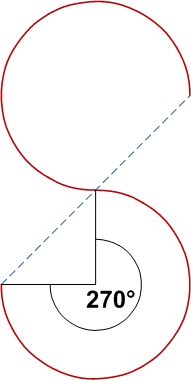Sinuosity
Sinuosity is a measure of how much a river, stream, or other channel meanders or follows a winding course compared to a straight line. It is a dimensionless quantity that quantifies the curvature or bends of a path. Sinuosity is calculated as the channel length divided by the straight-line distance from source to mouth. A perfectly straight channel would have a sinuosity of 1, while any value greater than 1 indicates some degree of meandering or winding.
Calculation[edit | edit source]
The formula to calculate sinuosity (S) is:
\[S = \frac{L}{D}\]
where \(L\) is the length of the channel and \(D\) is the straight-line distance from source to mouth. This formula highlights the relationship between the actual path length and the shortest possible path, with higher values indicating more deviation from a straight line.
Factors Influencing Sinuosity[edit | edit source]
Several factors can influence the sinuosity of a river or stream, including the topography of the land, the composition of the riverbed, the volume of water flow, and the amount of sediment being transported. In general, rivers tend to develop higher sinuosity in flatter landscapes where the water flow is less constrained by the topography. Additionally, rivers that carry a large amount of sediment are more likely to meander, as the deposition and erosion of sediment can alter the river's course over time.
Types of Channels Based on Sinuosity[edit | edit source]
Channels can be classified into several types based on their sinuosity:
- Straight channels have a sinuosity close to 1 and are rare in nature.
- Meandering channels exhibit high sinuosity, with numerous bends and turns.
- Braided channels may have a complex network of channels separated by small, often temporary, islands called braid bars. While individual channels in a braided river may have low sinuosity, the overall river system can appear highly sinuous when viewed from above.
Environmental and Ecological Significance[edit | edit source]
The sinuosity of a river or stream can have significant environmental and ecological implications. High sinuosity can enhance habitat diversity along the river course, supporting a wide range of aquatic and terrestrial species. Meandering rivers can also play a critical role in flood management, as the winding course can help to dissipate energy and reduce the speed of floodwaters.
Human Impact[edit | edit source]
Human activities, such as the construction of levees, dams, and channels, can significantly alter the natural sinuosity of rivers. These modifications can have profound impacts on river ecosystems, water quality, and flood management. Efforts to restore river sinuosity are part of many river restoration projects, aiming to return rivers to a more natural state for ecological and flood management benefits.
Search WikiMD
Ad.Tired of being Overweight? Try W8MD's physician weight loss program.
Semaglutide (Ozempic / Wegovy and Tirzepatide (Mounjaro / Zepbound) available.
Advertise on WikiMD
|
WikiMD's Wellness Encyclopedia |
| Let Food Be Thy Medicine Medicine Thy Food - Hippocrates |
Translate this page: - East Asian
中文,
日本,
한국어,
South Asian
हिन्दी,
தமிழ்,
తెలుగు,
Urdu,
ಕನ್ನಡ,
Southeast Asian
Indonesian,
Vietnamese,
Thai,
မြန်မာဘာသာ,
বাংলা
European
español,
Deutsch,
français,
Greek,
português do Brasil,
polski,
română,
русский,
Nederlands,
norsk,
svenska,
suomi,
Italian
Middle Eastern & African
عربى,
Turkish,
Persian,
Hebrew,
Afrikaans,
isiZulu,
Kiswahili,
Other
Bulgarian,
Hungarian,
Czech,
Swedish,
മലയാളം,
मराठी,
ਪੰਜਾਬੀ,
ગુજરાતી,
Portuguese,
Ukrainian
Medical Disclaimer: WikiMD is not a substitute for professional medical advice. The information on WikiMD is provided as an information resource only, may be incorrect, outdated or misleading, and is not to be used or relied on for any diagnostic or treatment purposes. Please consult your health care provider before making any healthcare decisions or for guidance about a specific medical condition. WikiMD expressly disclaims responsibility, and shall have no liability, for any damages, loss, injury, or liability whatsoever suffered as a result of your reliance on the information contained in this site. By visiting this site you agree to the foregoing terms and conditions, which may from time to time be changed or supplemented by WikiMD. If you do not agree to the foregoing terms and conditions, you should not enter or use this site. See full disclaimer.
Credits:Most images are courtesy of Wikimedia commons, and templates, categories Wikipedia, licensed under CC BY SA or similar.
Contributors: Prab R. Tumpati, MD


